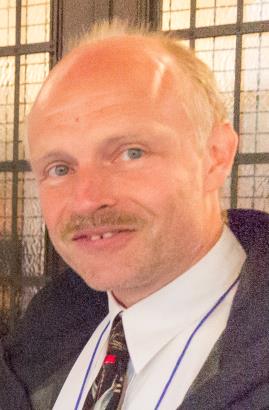|
Tuesday, September 19, 2016 - 08:30 - 09:30 |
 |
Andreas Martin, Infineon Technologies AG (GER)
|
|
Fast Wafer Level Reliability Monitoring as a tool to achieve automotive quality for a wafer process
After any process reliability qualification some tool is needed which verifies the stability of the process throughout mass production. A continuous “fast Wafer Level Reliability” (fWLR) Monitoring is essential especially for stringent product reliability specifications of automotive, medical or space applications. “Zero Defect” programs are well known and manifest the implementation of fWLR Monitoring on product wafers. However, often used quarterly reliability re-qualification cannot achieve this quality goal and is inappropriate. Therefore, fWLR Monitoring must be employed, covering reliability topics such as dielectric quality, plasma induced damage, device degradation and metallisation reliability. Additionally, fWLR can support a fast assessment of reliability during process development, split investigations, process tool changes and process qualifications.
In this tutorial an overview will be given on dedicated fWLR test structures, highly accelerated stress measurements, data analysis and sampling. Further, the challenges and limitations of the fWLR methodology will be pointed out as well as benefits will be highlighted. The topics of an out of control action plan, the scrapping of wafers with fWLR and defect density monitoring will be addressed.
This tutorial is suited for engineers and scientists who start in the area of reliability monitoring. But also experts who already work on this topic will benefit since also advanced methods are described. Valuable details and literature citations can be picked up. |
|
Thursday, September 22, 2016 - 08:30 - 09:30 |
 |
Gert Vogel, Siemens AG, Digital Factory Division, Control Products, DF CP QM SQA |
|
Creeping Corrosion of Copper on Printed Circuit Board Assemblies
The mechanism of creeping corrosion of copper will be explained. Creeping corrosion of copper occurs when low concentration of hydrogen sulfide (< 1 ppm H2S) in combination with a relative humidity greater than 60% meets with bare copper on the bottom of a crack or pinhole. The forming copper sulfide is immobile but can be attacked by oxidizing gases and will diffuse as mobile copper oxide out of the pinhole. There it is retransformed by attacking hydrogen sulfide to copper sulfide. |
|
Tuesday, September 20, 2016 - 08:30 - 09:30 |
|


|
Werner Kanert, Infineon Technologies, Munich
Eckhard Wolfgang, ECPE e.V., Nuremberg |
|
10 Years Robustness Validation
It is a truism that reliability is related to applications requirements. Robustness Validation (RV) is a methodology to provide data demonstrating that a product is "fit for use". The ZVEI working group Robustness Validation was initiated 10 years ago. The concept has received increasing attention over this period, also beyond the automotive qualification procedures it initially originated from. The tutorial gives an overview of the basic concept of RV and experiences made in applying it to development and qualification. Two examples are discussed in detail: qualification of power modules and of thin-film DC-link capacitors. It also discusses difficulties in applying the concept. |
|
Tuesday, September 20, 2016 - 08:30 - 09:30 |
 |
Enrico Zanoni, Dipartimento di Ingegneria dell’Informazione, Università degli Studi di Padova |
|
Field and time-dependent degradation of GaN HEMTs
For both microwave and power switching applications, Gallium Nitride (GaN) devices offer significant advantages with respect to their silicon and GaAs counterparts: high carrier mobility and carrier density, outstanding breakdown fields and the possibility of operating at very high temperature are reflected into the possibility of designing high efficiency and high frequency power amplifiers and power conversion systems. According to the targeted application and market, these devices are epitaxially grown on Si or SiC substrates, the option of GaN bulk substrates being still limited and expensive. Material defectivity, related with lattice mismatch between GaN and substrate, and the extremely high electric field values may cause potential reliability issues which are under intense investigation worldwide. This tutorial will review most recent works concerning the study of defects-related parasitic effects and of physical failure mechanisms of GaN devices.
After a short overview on the reliability of GaN HEMTs for microwave applications, the analysis will focus on the characterization of deep level effects in enhancement- and depletion-mode power GaN devices for switching applications. Threshold voltage instabilities in MISHEMT structures and their dependence on dielectric properties will be reviewed. Subsequently, it will be shown how the extremely high electric field values may lead to time dependent breakdown phenomena, affecting not only dielectric layers but also the GaN semiconductor itself. Recent data on the reliability of p-gate devices will be presented. Finally, breakdown mechanisms limiting the maximum device operating voltages will be reviewed. |
|
Wednesday, September 21, 2016 - 08:30 - 09:30 |
 |
Peter Jacob, Empa Dübendorf |
|
Failure mechanisms and precautions in plug connectors and relays
Plug connectors are one of the frequent failure causes when regarding at electronic systems. Since connectors had to keep pace with ongoing miniaturization on PCB level, current and voltage capabilities and specifications are frequently sportive or even overestimated. The tutorial focuses on the interfaces between connector and PCB as well as on connector-to cable and the connector contact itself, showing various failure mechanisms and precautions. Environmental conditions may also severely impact the connector reliability. The tutorial sensitizes the failure analyst to this underestimated topic and offers a deeper understanding and precaution measures against connector-related failures. Since many aspects considering plug connectors also apply for relays, the most important relay failure aspects are included in a small chapter of this tutorial. |